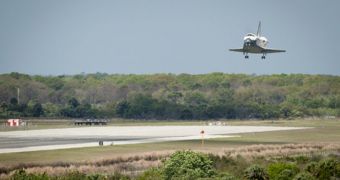The oldest and most flown orbiter in the American space fleet landed gracefully at a NASA spaceport yesterday, concluding nearly 27 years of continued operations. The final voyage of Discovery leaves astronauts and other personnel with a bittersweet feeling.
The shuttle landed for one last time at the Kennedy Space Center (KSC), in Florida, at 11:57 am EST (1657 GMT) on March 9, 2011. This also marked the end of the STS-133 assembly mission to the International Space Station (ISS).
After 13 years of efforts, the space lab has finally received all of its NASA rooms, coming dangerously close to being completed. Discovery launched in its final flight on February 24.
It traveled more than 5.3 million miles (8.53 million kilometers), and completed its task in roughly 12 days and 20 hours. During its stay in orbit, it delivered a new storage room for the station, an external cargo platform, and a humanoid robot.
Now, after the flight has ended, the fate of the shuttle is finally beginning to sink into the minds of those who handled the spacecraft for nearly three decades. The orbiter is to be decommissioned for good, have all its harmful chemicals removed, and then shipped to a museum.
The Smithsonian's National Air and Space Museum, in Washington DC, is the most likely candidate to receive the first retiring shuttle. However, there are currently about 29 museums in the competition to secure such a valuable display.
NASA is putting Discovery, Endeavor, Atlantis and Enterprise up for grabs. The museums need to compete amongst themselves in providing the American space agency with the best possible offers.
They need to show their dedication to the task at hand by building special pavilions, and by ensuring that the orbiter they get will be stored at a location that is visited around the year by numerous people.
The entire point of displaying the space shuttles is for as many citizens, both in the United States and abroad, to be fascinated by the amazing spacecraft. The Smithsonian, for example, is located in the American capital city, and is already visited by millions each year.
NASA spokespersons announced some time ago that the shuttles will also need to pass through a very thorough decontamination process before they are approved to go on public display.
The nose thrusters on Discovery, as well as the two engines on both sides of its tail, will soon be shipped to the NASA White Sands Space Harbor, in New Mexico, where they will be cleaned.
This process could take months, but then the shuttle will be put back together, and declared safe.
The final announcements on which museums will get which orbiter will be made by NASA Administrator Charles Bolden on April 12, Space reports.

 14 DAY TRIAL //
14 DAY TRIAL //